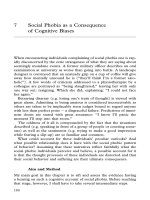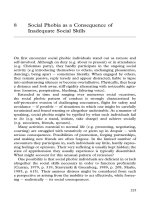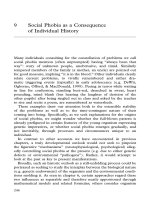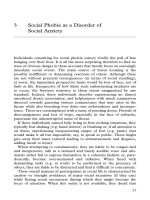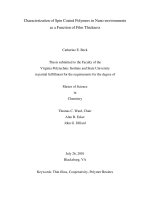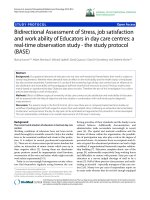Modeling teacher self-efficacy as a function of peer observation, administrative feedback, job satisfaction, and work enjoyment
Bạn đang xem bản rút gọn của tài liệu. Xem và tải ngay bản đầy đủ của tài liệu tại đây (287.02 KB, 13 trang )
Hue University Journal of Sciences: Social Science and Humanities
ISSN 2588–1213
Vol. 128, No. 6B, 2019, Tr. 71–83, DOI: 10.26459/hueuni-jssh.v128i6B.5265
MODELING TEACHER SELF-EFFICACY AS A FUNCTION
OF PEER OBSERVATION, ADMINISTRATIVE FEEDBACK,
JOB SATISFACTION, AND WORK ENJOYMENT
Nguyen Phuoc Hong Chau1, 2, Aaron Samuel Zimmerman1, *
1
College of Education, Texas Tech University, 3008 18th Street, Lubbock, TX 79409‐1071, USA
2 Phu Xuan University, 28 Nguyen Tri Phuong, Hue, Vietnam
Abstract. This study used a large‐scale, international data set – the Organization for Economic Co‐
operation and Development (OECD) – Teaching and Learning International Survey (TALIS) 2013, consist‐
ing of 14,583 teachers from 34 countries – to examine the manner in which feedback from administrators,
time spent observing colleagues’ classes, job satisfaction, and work enjoyment predicted teachers’ instruc‐
tional self‐efficacy. To guide the present study, Bandura’s (1986, 1997) part of the social cognitive theory –
that is, self‐efficacy theory – is utilized. We adopted Bandura’s self‐efficacy theory as the framework, for it
provides a valuable lens through which we could identify the predictors of teacher self‐efficacy to include
in the model investigated in this study. The results of this study suggest that feedback from administrators
was not a significant predictor of teacher self‐efficacy for instruction, whilst peer observation, job satisfac‐
tion, and work enjoyment were estimated as being significant predictors. These results have implications
for practice – specifically, how teachers and school leaders should cultivate teachers’ self‐efficacy for in‐
struction – and future research.
Keywords: teacher self‐efficacy, administrative feedback, peer observation, job satisfaction, work enjoy‐
ment
1.
Introduction
Grounded in Bandura’s (1986) social cognitive theory (see next section), Skaalvik and
Skaalvik (2010) conceptualized teacher self‐efficacy as “individual teachers’ beliefs in their own
ability to plan, organize, and carry out activities that are required to attain given educational
goals” (p. 1059). A large body of existing research has shown that teacher self‐efficacy occupies
a crucial role in enhancing the effectiveness of teacher teaching and student learning. Specifical‐
ly, on the one hand, teacher self‐efficacy correlates positively with teacher well‐being (e.g.,
Brouwers & Tomic, 2000; Zee & Koomen, 2016), teacher professional practices (e.g., Gibson &
Dembo, 1984), teacher job satisfaction (e.g., Avanzi et al., 2013; Caprara, Barbaranelli, Borgogni,
& Steca, 2003), teacher commitment to teaching (e.g., Chesnut & Burley, 2015; Coladarci, 1992;
* Corresponding:
Submitted: 24–05–2019; Revised: 05–06–2019; Accepted: 21–06–2019.
Nguyen Phuoc Hong Chau, Aaron Samuel Zimmerman
Vol. 128, No. 6B, 2019
Evans & Tribble, 1986), student motivation (e.g., Dembo & Gibson, 1985), and student achieve‐
ment (e.g., Anderson, Greene, & Loewen, 1988; Kassen & Tze, 2014; Ross, 1992; Tschannen‐
Moran & Johnson, 2011). On the other hand, teacher self‐efficacy has a negative correlation with
teacher burnout (e.g., Betoret, 2006; Chwalisz, Altmaier, & Russell, 1992; Evers, Brouwers, &
Tomic, 2002; Skaalvik & Skaalvik, 2009). Morris and Usher (2011) contended, “Although a
growing body of research attests to the benefits associated with teaching self‐efficacy, less is
known about how teaching self‐efficacy is cultivated” (pp. 232–233). Responding to this gap in
the research literature, the present study was designed to examine the manner in which feed‐
back from administrators, time spent observing colleagues’ classes, job satisfaction, and work
enjoyment predicted teacher self‐efficacy for instruction.
2.
Theoretical framework
This study was guided by Bandura’s (1986, 1997) part of the social cognitive theory – that
is, self‐efficacy theory which is depicted as follows:
2.1.
Definition of self-efficacy
In his social cognitive theory, Bandura (1986) defines self‐efficacy as “people’s judge‐
ments of their capabilities to organize and execute courses of action required to attain designat‐
ed types of performances” (p. 391). Bandura emphasizes, “[Self‐efficacy] is concerned not with
the skills one has but with judgements of what one can do with whatever skills one possesses”
(p. 391).
2.2.
Principal sources of self-efficacy
Bandura (1997) theorizes that self‐efficacy beliefs are constructed as individuals interpret
information from four major sources: (a) enactive mastery experience, (b) vicarious experience,
(c) verbal persuasion, and (d) physiological and affective states. Of these four self‐efficacy
sources, enactive mastery experience, Bandura postulates, is the most influential since it is de‐
rived from one’s own personal experience, hence is the most authentic evidence of one’s capa‐
bilities. He posits that performance successes would raise one’s self‐efficacy; whereas repeated
performance failures would undermine it. In respect of the second source, Bandura explains
that one’s self‐efficacy is also influenced by his/her vicarious experience – that is, visualizing
other people perform, through which he/she can compare his/her performance with that of oth‐
ers and form a perception of his/her own capabilities. Regarding verbal persuasion, Bandura
claims one’s self‐efficacy could be bolstered if others verbally persuade him/her that, for in‐
stance, he/she is capable to successfully perform a certain task. It should, however, be noted that
the effectiveness of verbal persuasion (e.g., praise and evaluative feedback) is mediated not only
72
Jos.hueuni.edu.vn
Vol. 128, No. 6B, 2019
by who provides it, but also by the way in which the message is constructed (Bandura, 1997;
Morris, Usher, & Chen, 2017; Pajares, 2006). For example, feedback from peers or inexperienced
people tends to exert less influence upon one’s efficacy beliefs compared with that from profes‐
sional experts or those who are experienced (Bandura, 1997). Or, as found by Parajes (2016),
“knee‐jerk praise or empty inspirational homilies” (p. 349) are unlikely to be an effective means
of nurturing one’s positive beliefs about their capabilities. Finally, one’s physiological and affec‐
tive states are also important indicators one uses to judge his/her efficacy. Such states comprise,
for example, “stress, fatigue, anxiety, and mood” (Morris et al., 2017, p. 798). For instance, when
one is suffering from fatigue or pains, his/her self‐efficacy tends to be lowered compared with
when he/she is in a good mood. We summarize Bandura’s theoretical framework for sources of
self‐efficacy as follows:
Enactive mastery experience
………………..
Performance accomplish‐
ments/successes
Physiological and affec‐
tive states
Vicarious experience
………………..
Observations of the self,
others, or models
……………….
e.g., stress, fatigue, an‐
xiety, enjoyment, or
happiness
Social/Verbal persuasions
………………….
e.g., praise, appraisal, or
evaluative feedback
Figure 1. Theoretical framework for sources of self‐efficacy (Bandura, 1997)
This theoretical framework informs the variables included in the model investigated in
this study. Said differently, the present study addresses the following research question: How
do feedback from one’s administrators (verbal persuasion), observation of one’s peers (vica‐
73
Nguyen Phuoc Hong Chau, Aaron Samuel Zimmerman
Vol. 128, No. 6B, 2019
rious experience), satisfaction with one’s own performance (enactive mastery experience), and
enjoyment of one’s own work (physiological and affective states) contribute to the development
of teachers’ instructional self‐efficacy?
3.
Literature review
In the existing literature, there is a large body of both quantitative and qualitative re‐
search examining the influence of Bandura’s four hypothesized sources on teacher self‐efficacy.
The majority of the extant studies indicate that all four sources play roles in teacher self‐efficacy
development (e.g., Hendricks, 2016; Pfitzner‐Eden, 2016; Phan & Locke, 2015; Poulou, 2007).
However, those study results are not consistent with respect to the strength of each source. For
example, Morris and Usher (2011), Pfitzner‐Eden (2016), Poulou (2007), and Tschannen‐Moran
and McMaster (2009) found that mastery experience wields the greatest effect on teacher self‐
efficacy. In contrast, the studies by Johnson (2010) and Mills (2011) demonstrated that vicarious
experience is the most influential source of teaching self‐efficacy. Meanwhile, other researchers
have observed that verbal persuasion is the predominant source that can raise or diminish
teacher self‐efficacy (Aydin & Hoy, 2005; Milner, 2002; Milner & Hoy, 2003; Phan & Locke,
2015). Completely different from the above‐mentioned findings, the study by Palmer (2006)
indicated that most of Bandura’s sources of self‐efficacy, including enactive mastery experience,
vicarious experience, and verbal persuasion are not significant factors contributing towards
teacher self‐efficacy. The main source of teacher self‐efficacy, found in Palmer’s study, is cogni‐
tive pedagogical mastery – that is, “successes in understanding how to teach” (p. 349). Palmer
considered this factor (cognitive pedagogical mastery) a potential additional source of self‐
efficacy in relation to those hypothesized by Bandura.
The literature suggests the inconsistencies regarding the impact level of Bandura’s
sources on teacher efficacy beliefs. In addition, there are still few studies investigating this issue
in international or cross‐nations contexts. In response to this need, the present study was con‐
ducted utilizing a large‐scale, international data set with the participation of teachers from 34
countries to reexamine this issue.
4.
Methodology
4.1.
Statistical method
To examine how feedback from one’s administrators, observation of one’s peers, satisfac‐
tion with one’s own performance, and enjoyment of one’s own work contribute to the devel‐
opment of teachers’ instructional self‐efficacy, multiple linear regression was employed. Urdan
(2017) writes that multiple linear regression “allows researchers to examine the nature and
74
Jos.hueuni.edu.vn
Vol. 128, No. 6B, 2019
strength of the relations between variables, the relative predictive power of several independent
variables on a dependent variable” (p. 183). In addition, as explained by Field (2013), this form
of statistical modeling is “a method in which all predictors are forced into the model simulta‐
neously” (p. 322). The predictors used in the present study (i.e., feedback from one’s adminis‐
trators, observation of one’s peers, satisfaction with one’s own performance, and enjoyment of
one’s own work) were selected based entirely on the self‐efficacy theoretical framework by
Bandura (1997).
4.2.
Data sources and variables
The sample of this study, which was drawn from the OECD Teaching and Learning In‐
ternational Survey (TALIS) 2013 data set, consisted of 14,583 teachers from 34 countries (OECD,
2014). The survey questions included in the model as independent variables were presented in
Table 1. These questions were answered on a Likert scale, with Items 46‐TT2G46I, 31‐TT2G31C,
and 46‐TT2G46E using a 4‐point scale from strongly disagree to strongly agree, and Item 33‐
TT2G33B asking about the frequency of peer observation using a 6‐point scale from never to once
a week or more. Note that the TALIS 2013 employed a 4‐point scale from strongly disagree to
strongly agree in lieu of a 5‐point scale. However, this is not a concern because, as admitted by
Dillman, Smyth, and Christian (2014):
[W]hile many people agonize over the decision of whether or not to offer a midpoint
[such as “neutral” or “neither disagree nor agree"], the literature suggests whether one of‐
fers a midpoint has little effect on the resulting data quality and conclusions drawn from
the data. (p. 154)
Table 1. Independent variables included in the model
Independent Variables
Questions/Items
Scales
Performance satisfaction
46. How strongly do you agree or disag‐
1 – Strongly disagree
ree
2 – Disagree
Peer observation
with
the
following
statement?
TT2G46I – I am satisfied with my perfor-
3 – Agree
mance in this school.
4 – Strongly agree
33. On average, how often do you do
1 – Never
the following in this school? TT2G33B –
2 – Once a year or less
Observe other teachers’ classes and provide
3 – 2‐4 times a year
feedback.
4 – 5‐10 times a year
5 – 1‐3 times a month
6 – Once a week or more
Administrative feedback
31. How strongly do you agree or disag‐
1 – Strongly disagree
ree with the following statement about
2 – Disagree
this school? TT2G31C – Teacher appraisal
3 – Agree
75
Nguyen Phuoc Hong Chau, Aaron Samuel Zimmerman
and feedback are largely done to fulfil ad-
Vol. 128, No. 6B, 2019
4 – Strongly agree
ministrative requirements.
Work enjoyment
46. How strongly do you agree or disag‐
1 – Strongly disagree
ree
2 – Disagree
with
the
following
statement?
TT2G46E – I enjoy working at this school.
3 – Agree
4 – Strongly agree
The dependent variable in the model was assessed through the following survey ques‐
tion, measured on a 4‐point Likert scale:
Table 2. Dependent variable included in the model
Dependent Variable
Question/Item
Scale
Teachers’ instructional self‐
34. In your teaching, to what extent can
1 – Not at all
efficacy
you do the following? TT2G34L – Imple-
2 – To some extent
ment alternative instructional strategies in
3 – Quite a bit
my classroom.
4 – A lot
Concerning the validity of self‐efficacy measures, Bandura (2006) emphasizes, “Efficacy
items should accurately reflect the construct. Self‐efficacy is concerned with perceived capabili‐
ty. The items should be phrased in terms of can do rather than will do. Can is a judgment of ca‐
pability; will is a statement of intention” (p. 308, italics original). Furthermore, Bandura (2006)
maintains, “Perceived self‐efficacy is a judgment of capability to execute given types of perfor‐
mances” (p. 309). That is, as elucidated by Klassen and Usher (2010), self‐efficacy meas‐
ures/scales need to adhere to the tenet of specificity; they should be constructed in the way that
can measure one’s judgements of their capabilities “to carry out specific tasks or in a specific
domain” (p. 19). The item/question used in this study (which measures teachers’ self‐efficacy for
implementing alternative instructional strategies) is congruent with Bandura’s (1986) definition
of self‐efficacy (i.e., one’s beliefs about their competence to produce given attainments rather
than their actual capability or intention) as well as with Bandura’s (2006) principle of specificity.
This item can, therefore, be seen as a valid measure of self‐efficacy within the scope of the
present study, for it “measure[s] what [it] purport[s] to measure” (Bandura, 2006, p. 318).
4.3.
Data analysis
The data related to the five above‐mentioned variables were first screened to identify and
evaluate the seriousness of missing cases. This first step produced the results that the variable
job satisfaction had 3.7% cases missing, peer observation 3.7%, administrative feedback 7.3%,
work enjoyment 3.8%, and teacher self‐efficacy for instructional strategies 3.7%. Because the
sample size is large (14,583 participants), and all the variables each had less than 10% cases
missing, Listwise was utilized to exclude those missing cases from the whole analysis (Mertler &
76
Jos.hueuni.edu.vn
Vol. 128, No. 6B, 2019
Reinhart, 2017). Thereafter, the data were screened again to evaluate the normal distribution of
the variables; the evaluation indicates that the normality of distributions of these five variables
is tenable. Finally, multiple linear regression analysis was conducted employing SPSS to deter‐
mine how feedback from one’s administrators, observation of one’s peers, satisfaction with
one’s own performance, and enjoyment of one’s own work contribute towards nurturing teach‐
ers’ instructional self‐efficacy.
5.
Results
A multiple linear regression analysis was conducted to examine the manner in which
feedback from administrators, time spent observing colleagues’ classes, job satisfaction, and
work enjoyment predicted teacher self‐efficacy for instructional strategies. As previously men‐
tioned, all these four predictors were concurrently entered into the model. The regression re‐
sults demonstrated that tolerance was high (0.859 for job satisfaction, 0.980 for peer observation,
0.947 for administrative feedback, and 0.832 for work enjoyment), suggesting that multi‐
collinearity was not a concern (Mertler & Reinhart, 2017). The results of the estimation of the
coefficients for the linear regression model revealed that the overall model significantly pre‐
dicted the level of teacher self‐efficacy for instruction R2 = 0.062, R2adj. = 0.062, F(4,13154) =
218.617, p < 0.001. However, as the results demonstrated, this model accounted for only 6.2 per‐
cent of the variance in teacher self‐efficacy for instructional strategies, leaving up to 93.8 percent
of the variance in teachers’ instructional self‐efficacy unexplained. The results also indicated
that out of the four independent variables included in the model, job satisfaction (β = 0.203, p <
0.001) was the strongest predictor and positively related with teacher instructional self‐efficacy,
followed by time spent observing other teachers’ classes (β = 0.089, p < 0.001), and work enjoy‐
ment (β = 0.046, p < 0.001). These two predictors were also positively associated with teacher
instructional self‐efficacy. Interestingly, the coefficient estimate for feedback from administra‐
tors (β = –0.010, p = 0.226) was not statistically significant. A post hoc analysis was then also con‐
ducted using G*Power to calculate the power for this multiple regression design. The power
achieved was 1.0, indicating a high level of power which reduces the chance of making a type II
error (Mertler & Reinhart, 2017). A summary of regression coefficients is presented in Table 3.
Table 3. Coefficients for model variables
B
β
t
p
Bivariate r
Partial r
Job satisfaction
0.281
0.203
22.279
<0.001
0.227
0.191
Time spent observing colleagues’
classes
0.042
0.089
10.465
<0.001
0.108
0.091
Feedback from administrators
–0.010
–0.010
–10.210
0.226
–0.052
–0.011
Work enjoyment
0.054
0.046
4.974
<0.001
0.131
0.043
77
Nguyen Phuoc Hong Chau, Aaron Samuel Zimmerman
6.
Vol. 128, No. 6B, 2019
Discussion and conclusion
The results indicate that first, teachers who are more satisfied with their teaching perfor‐
mance are most likely to have a higher level of instructional self‐efficacy than those who are not.
Second, teachers who spend more time observing the teaching of their peers tend to be more
confident in their ability for instruction as opposed to those spending less time in so doing.
Third, teachers with more work enjoyment report having a higher level of self‐efficacy for in‐
struction compared with those with less work enjoyment. It is worth noting that of the three
variables significantly contributing to informing teacher instructional self‐efficacy, teaching
performance satisfaction is the most influential predictor; whereas, feedback from administra‐
tors does not appear to have an influence. These results are, on the one hand, consistent with
Bandura’s (1997) theory as well as previous empirical research (e.g., Morris & Usher, 2011;
Pfitzner‐Eden, 2016; Poulou, 2007; Tschannen‐Moran & Hoy, 2007) suggesting that enactive
mastery experience (i.e., self‐perception of successful job performance) is the most powerful
factor supporting the development of teachers’ instructional self‐efficacy. On the other hand,
the results of this study contradict the assertion that verbal persuasion (i.e., appraisal and feed‐
back) is a primary source of teacher self‐efficacy (cf. Aydin & Hoy, 2005; Bandura, 1997; Milner,
2002; Milner & Hoy, 2003; Pfitzner‐Eden, 2016; Phan & Lock, 2015). Regarding verbal persua‐
sion, Bandura (1997) and Parajes (2016) state that its potency depends on the credibility and
knowledgeableness or expertise of the persuader. Similarly, Pitts, Davidson, and McPherson
(2000) posit that appraisal and feedback are meaningful only when they are specific and ge‐
nuine. Due to the dearth of qualitative data, the reason for administrative feedback being an
insignificant predictor of teacher self‐efficacy, in this study, is left unexplained. To address this
limitation, more qualitative studies are needed to provide explanations for these quantitative
findings. In addition, further research is also warranted to identify the remaining predictors of
teacher self‐efficacy which are still unknown in this model.
These limitations notwithstanding, the results of the present study significantly contri‐
bute to the field as well as offer several implications for practice – specifically, how teachers and
school leaders should cultivate teachers’ self‐efficacy for instruction – and future research.
7.
Implications
Teachers’ self‐efficacy correlates positively with teacher well‐being (e.g., Zee & Koomen,
2016), teacher professional practices (e.g., Gibson & Dembo, 1984), teacher job satisfaction (e.g.,
Avanzi et al., 2013), teacher commitment to teaching (e.g., Chesnut & Burley, 2015), and student
achievement (e.g., Kassen & Tze, 2014); thus, cultivating teachers’ self‐efficacy should be one of
the primary goals within schools. The current study has important implications for schools to
consider in this respect. First, as the results of this study indicate, teachers’ sense of efficacy can
78
Jos.hueuni.edu.vn
Vol. 128, No. 6B, 2019
be nurtured through enactive, vicarious, and physiological and affective means with enactive
experience being the most influential. It is hence desirable that teachers be, in Schön’s (1983)
words, reflective practitioners. That is, they should self‐reflect on their own teaching perfor‐
mance regularly not only to gain real‐world experience or transform their professional practice
(Dewey, 1933, 1938; Schön; 1983), but also to enjoy and celebrate their success since, as these
findings reveal, experiencing a sense of instructional accomplishment will most likely streng‐
then teachers’ beliefs about their efficacy. According to Schön (1983), there are two ways in
which teachers can reflect on their practice: reflection in action (i.e., teacher reflection occurs
during or in the midst of ongoing action/teaching) and reflection on action (i.e., teacher reflec‐
tion takes place after action/teaching) (see Schön, 1983).
Furthermore, this investigation’s findings demonstrate that verbal persuasion (i.e., ap‐
praisal and feedback) from administrators do not seem to contribute significantly to teachers’
instructional self‐efficacy. Given these findings, administrators should, perhaps, rely less on
administrative feedback as the primary mode for increasing teachers’ instructional self‐efficacy.
Instead, the results of this study suggest that it may be far more effective for schools to create
opportunities for teachers to observe one another, and more importantly, engage in peer review
of one another’s teaching (see Bernstein, 2008). It merits noting that teachers should be involved
in these activities (i.e., peer observations, and/or – to quote Bernstein (2008, p. 48) – “peer re‐
view of teaching”) in a frequent manner because, as postulated by Bandura (1997) and Morris et
al. (2017), not only the quality of events, but also the frequency an individual takes part in those
events is of crucial importance in building teacher self‐efficacy. As Morris et al. (2017) explain,
“[T]eachers may become more confident from their observations of other teachers, but if oppor‐
tunities to watch their colleagues are limited, so too may be the influence of these vicarious ex‐
periences on teaching self‐efficacy” (p. 823).
The results of this study also, as noted earlier, suggest directions for future research. Spe‐
cifically, although the coefficients estimated within this regression model were statistically sig‐
nificant, the model itself explained only approximately 6% of the variability observed in the
dependent variable. Thus, future research should continue to investigate causes of how and
why teachers feel confident to implement different instructional strategies in their classrooms.
Additionally, it is worth noting that the current study utilized data taken from an international
sample of teachers. Future studies may want to examine how teacher self‐efficacy is cultivated
within different local contexts and to see if Bandura’s model is mediated by contextual va‐
riables.
79
Nguyen Phuoc Hong Chau, Aaron Samuel Zimmerman
Vol. 128, No. 6B, 2019
References
1.
Anderson, R. N., Greene, M. L., & Loewen, P. S. (1988). Relationships among teachers’
and students’ thinking skills, sense of efficacy, and student achievement. Alberta Journal of
Educational Research, 34(8), 148–165.
2.
Avanzi, L., Miglioretti, M., Velasco, V., Balducci, C., Vecchio, L., Fraccaroli, F., & Skaal‐
vik, E. M. (2013). Cross‐validation of the Norwegian teacher's self‐efficacy scale
(NTSES). Teaching and Teacher Education, 31(3), 69–78.
3.
Aydin, Y. C., & Hoy, A. W. (2005). What predicts student teacher self‐efficacy? Academic
Exchange Quarterly, 9(4), 123–127.
4.
Bandura, A. (1986). Social foundations of thought and action: A social cognitive theory. New
Jersey, NJ: Prentice‐Hall, Inc.
5.
Bandura, A. (1997). Self-efficacy: The exercise of control. New York, NY: Freeman.
6.
Bandura, A. (2006). Guide for constructing self‐efficacy scales. Self-Efficacy Beliefs of Adolescents, 5(1), 307–337.
7.
Bernstein, D. J. (2008). Peer review and evaluation of the intellectual work of teach‐
ing. Change: The Magazine of Higher Learning, 40(2), 48–51.
8.
Betoret, F. D. (2006). Stressors, self‐efficacy, coping resources, and burnout among sec‐
ondary school teachers in Spain. Educational Psychology, 26(4), 519–539.
9.
Brouwers, A., & Tomic, W. (2000). A longitudinal study of teacher burnout and perceived
self‐efficacy in classroom management. Teaching and Teacher Education, 16(3), 239–25.
10. Caprara, G. V., Barbaranelli, C., Borgogni, L., & Steca, P. (2003). Efficacy beliefs as deter‐
minants of teachers' job satisfaction. Journal of Educational Psychology, 95(4), 821–832.
11. Chesnut, S. R., & Burley, H. (2015). Self‐efficacy as a predictor of commitment to the
teaching profession: A meta‐analysis. Educational Research Review, 15, 1–16.
12. Chwalisz, K., Altmaier, E. M., & Russell, D. W. (1992). Causal attributions, self‐efficacy
cognitions, and coping with stress. Journal of Social and Clinical Psychology,11(9), 377–400.
13. Coladarci, T. (1992). Teachers' sense of efficacy and commitment to teaching. The Journal
of Experimental Education, 60(4), 323–337.
14. Dillman, D. A., Smyth, J. D., & Christian, L. M. (2014). Internet, phone, mail, and mixed-mode
surveys: The tailored design method. New Jersey, NJ: John Wiley & Sons.
80
Jos.hueuni.edu.vn
Vol. 128, No. 6B, 2019
15. Dembo, M. H., & Gibson, S. (1985). Teachers’ sense of efficacy: An important factor in
school improvement. The Elementary School Journal, 86(2), 173–184.
16. Dewey, J. (1933). How we think: A restatement of the relation of reflective thinking to the educative process. Boston, MA: Heath.
17. Dewey, J. (1938). Experience and education. New York, NY: Macmillan.
18. Evans, E. D., & Tribble, M. (1986). Perceived teaching problems, self‐efficacy, and com‐
mitment to teaching among preservice teachers. The Journal of Educational Research, 80(2),
81–85.
19. Evers, W. J., Brouwers, A., & Tomic, W. (2002). Burnout and self‐efficacy: A study on
teachers' beliefs when implementing an innovative educational system in the Nether‐
lands. British Journal of Educational Psychology, 72(2), 227–243.
20. Field, A. (2013). Discovering statistics using IBM SPSS statistics. Los Angeles, CA: Sage.
21. Gibson, S., & Dembo, M. H. (1984). Teacher efficacy: A construct validation. Journal of
Educational Psychology, 76(8), 669–682.
22. Hendricks, K. S. (2016). The sources of self‐efficacy: Educational research and implica‐
tions for music. National Association for Music Education, 35(1), 32–38.
23. Johnson, D. (2010). Learning to teach: The influence of a university‐school partnership
project on pre‐service elementary teachers’ efficacy for literacy instruction. Reading Horizons, 50(1), 23–48.
24. Klassen, R. M., & Tze, V. M. (2014). Teachers’ self‐efficacy, personality, and teaching ef‐
fectiveness: A meta‐analysis. Educational Research Review, 12, 59–76.
25. Klassen, R. M., & Usher, E. L. (2010). Self‐efficacy in educational settings: Recent research
and emerging directions. In T. C. Urdan & S. A. Karabenick (Eds.), Advances in motivation
and achievement: Vol. 16A. The decade ahead: Theoretical perspectives on motivation and
achievement (pp. 1–33). Bingley, UK: Emerald Publishing Group.
26. Mertler, C. A., & Reinhart, R. V. (2017). Advanced and multivariate statistical methods: Practical application and interpretation. New York, NY: Routledge.
27. Mills, N. (2011). Teaching assistants’ self‐efficacy in teaching literature: Sources, personal
assessments, and consequences. The Modern Language Journal, 95(1), 61–80.
28. Milner, H. R. (2002). A case study of an experienced English teacher’s self‐efficacy and
persistence through “crisis” situations: Theoretical and practical considerations. The High
School Journal, 86(1), 28–35.
81
Nguyen Phuoc Hong Chau, Aaron Samuel Zimmerman
Vol. 128, No. 6B, 2019
29. Milner, H. R., & Hoy, A. W. (2003). A case study of an African American teacher’s self‐
efficacy, stereotype threat, and persistence. Teaching and Teacher Education, 19(2), 263–276.
30. Morris, D. B., & Usher, E. L. (2011). Developing teaching self‐efficacy in research institu‐
tions: A study of award‐winning professors. Contemporary Educational Psychology, 36(3),
232–245.
31. Morris, D. B., Usher, E. L., & Chen, J. A. (2017). Reconceptualizing the sources of teaching
self‐efficacy: A critical review of emerging literature. Educational Psychology Review, 29(4),
795–833.
32. OECD. (2014). TALIS 2013 results: An international perspective on teaching and learning. Par‐
is: OECD Publishing. Retrieved from: />results.htm
33. Pajares, F. (2006). Self‐efficacy during childhood and adolescence: Implications for teach‐
ers and parents. In F. Pajares & T. Urdan (Eds.), Self-efficacy beliefs of adolescents (pp. 117–
137). Greenwich: Information Age Publishing.
34. Palmer, D. H. (2006). Sources of self‐efficacy in a science methods course for primary
teacher education students. Research in Science Education, 36(4), 337–353.
35. Pfitzner‐Eden, F. (2016). Why do I feel more confident? Bandura’s sources predict preser‐
vice teachers’ latent changes in teacher self‐efficacy. Frontiers in Psychology, 7, 1–16.
36. Phan, N. T. T., & Locke, T. (2015). Sources of self‐efficacy of Vietnamese EFL teachers: A
qualitative study. Teaching and Teacher Education, 52, 73–82.
37. Pitts, S. E., Davidson, J. W., & McPherson, G. E. (2000). Models of success and failure in
instrumental learning: Case studies of young players in the first 20 months of learn‐
ing. Bulletin of the Council for Research in Music Education, 146, 51–69.
38. Poulou, M. (2007). Personal teaching efficacy and its sources: Student teachers’ percep‐
tions. Educational Psychology, 27(2), 191–218.
39. Ross, J. A. (1992). Teacher efficacy and the effects of coaching on student achievement.
Canadian Journal of Education, 17(1), 51–65.
40. Schon, D. A. (1983). The reflective practitioner: How professionals think in action. New York,
NY: Basic Books.
41. Skaalvik, E. M., & Skaalvik, S. (2009). Does school context matter? Relations with teacher
burnout and job satisfaction. Teaching and Teacher Education, 25(9), 518–524.
82
Jos.hueuni.edu.vn
Vol. 128, No. 6B, 2019
42. Skaalvik, E. M., & Skaalvik, S. (2010). Teacher self‐efficacy and teacher burnout: A study
of relations. Teaching and Teacher Education, 26, 1059–1069.
43. Tschannen‐Moran, M., & Hoy, A. W. (2007). The differential antecedents of self‐efficacy
beliefs of novice and experienced teachers. Teaching and Teacher Education, 23(6), 944–956.
44. Tschannen‐Moran, M., & Johnson, D. (2011). Exploring literacy teachers’ self‐efficacy be‐
liefs: Potential sources at play. Teaching and Teacher Education, 27(2), 751–761.
45. Tschannen‐Moran, M., & McMaster, P. (2009). Sources of self‐efficacy: Four professional
development formats and their relationship to self‐efficacy and implementation of a new
teaching strategy. The Elementary School Journal, 110(2), 228–245.
46. Urdan, T. C. (2017). Statistics in plain English. New York, NY: Routledge.
47. Zee, M., & Koomen, H. M. Y. (2016). Teacher self‐efficacy and its effects on classroom
processes, student academic adjustment, and teacher well‐being: A synthesis of 40 years
of research. Review of Educational Research, 86, 981–1015.
83


